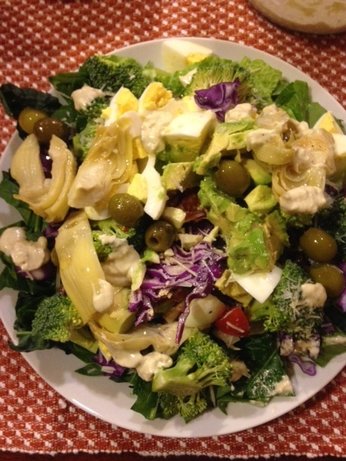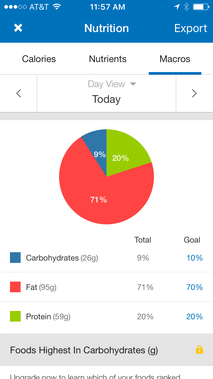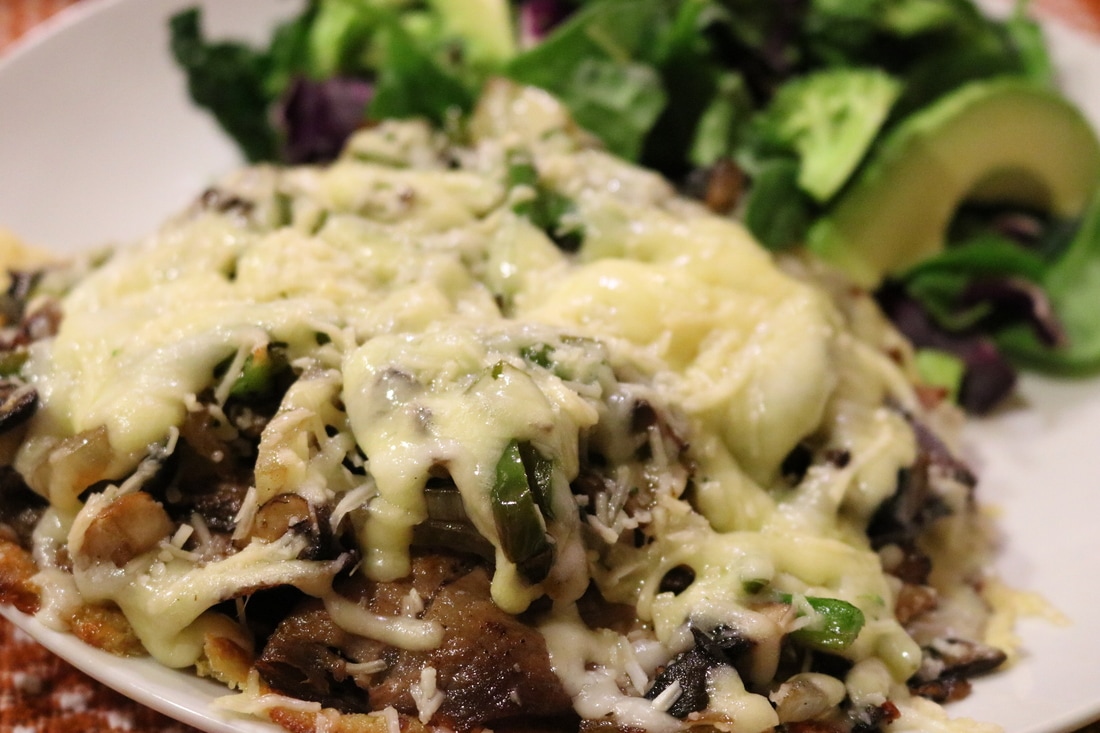 My "salad" which includes kale, spinach, lettuce, avocado, hard boiled egg, tomato, broccoli, cabbage, cheese, green olives, artichoke hearts, and sometimes bacon covered in homemade lemon vinaigrette dressing and MCT oil. My "salad" which includes kale, spinach, lettuce, avocado, hard boiled egg, tomato, broccoli, cabbage, cheese, green olives, artichoke hearts, and sometimes bacon covered in homemade lemon vinaigrette dressing and MCT oil. My Current Regimen And Personal Stats Over the past year of eating this high fat, moderate protein, low carb diet, I have found that certain foods and times of eating tend to work better for me than others. So far, for myself, this is what I have learned. I start out my day with the previously mentioned Bulletproof coffee or tea, which take the place of breakfast for me and allow my body to stay in a "fasting state" until lunch. For me, I drink my coffee/tea around 6am, after completing some morning routine items that includes my morning gut drink. (check out My Morning Routine Here). I will then workout and head to work where I will consume only water until lunch, which I eat at about 1:30pm. I don't snack because I don't get hungry between meals. The morning coffee/tea keeps me full until my lunch. Lunch consists mostly of leftovers from dinner the night before. This can vary, but usually includes a generous portion of “salad” and some small portion of protein and/or some hard cheese. Now, I should point out that when I say “salad”, this includes; kale, spinach, lettuce, avocado, hard boiled egg, tomato, broccoli, cabbage, cheese, green olives, artichoke hearts, and sometimes bacon covered in homemade lemon vinaigrette dressing and MCT oil. This is one of my go-to items and can be a stand alone meal, or with other times. This salad, which you can see covers most of my bases for nutritional needs, and tastes delicious. I will then head back to work until the evening when it is time to come home for dinner, around 7:30pm. This meal can vary a lot, but almost always includes a slightly scaled down version of my salad. Also, some sort of protein, which could be anything from burgers, to meatloaf to “reuben sandwiches”, chicken curry, stuffed chicken, pork shoulder, salmon, halibut, and many more. All of these recipes have been modified and made specifically for this diet, which is an important component of this food selection. One of the biggest differences from how I used to eat compared to how I am eating now is, smaller portions of protein with my meals. This can seem counter to what most people preach and is counter to what I did for a long time. I think it can be an important component of keeping your overall glucose levels down. This is to avoid protein to glucose conversion from having too much protein via gluconeogenesis. This can mean that even a low carb diet can be problematic if you have "too much" protein.  A sample meal macronutrient breakdown on myfitnesspal app. 70% Fat, 20% Protein, 10% Carbohydrates. A sample meal macronutrient breakdown on myfitnesspal app. 70% Fat, 20% Protein, 10% Carbohydrates. The tricky part with this is it seems to be different for everybody regarding how much protein is "too much". This can take some trial and error to figure out exactly how much protein your body needs, but I try to be around 20% of my daily total caloric intake, which tends to be around 100-150 grams of protein for me daily. This has been after lots of trial and error and is not aways perfectly exact. I also don't necessarily hit the same numbers everyday. I also didn't get to these numbers by measuring everything out first, and only eating what I calculated. I simply began by eating the amounts I was hungry for and felt that I needed and after a week or so of this, I would input the data into myfitnesspal which is a free app that will calculate your food intake calories, macronutrients and even micronutrients. After seeing where my numbers where at, based on my eating, I would adjust for usually less protein and more fat which is usually where I faltered. Through this process I learned more about the foods I was eating too, like how nuts can have more carbohydrates than I always thought. Keep in mind also, that I am about 160 lbs and workout most days including Crossfit and other HIIT workouts throughout the week. I have a very sensitive digestive system and am also NOT a competitive athlete. Therefore my nutritional goals, focus, and needs will most likely be different than yours. Make sure to always consult your physician or nutritionist before making any dietary changes. As previously discussed, the macronutrient ration goal of the ketogenic diet is somewhere in the range of 70% Fat, 20% Protein, and 10% Carbohydrates. Now remember, this is the percentage of each macronutrient based on total calories (food intake) NOT percentage of volume of food. Remember, 1 gram of Fat is 9 calories, while 1 gram of Protein and 1 gram of Carbs are both 4 calories each. This means that it doesn't take as much volume of foods that are high in fat as it does for protein or carbs to make up the same number of calories. The way I think of it is that, if my plate is 3/4 vegetables (including avocado, olive oil and/or MCT oil), and the last 1/4 split between protein and fat, I will be good. The vegetables include much needed fiber, which is vary important when eating a high fat diet. The food tastes good and keeps me full, lean and full of energy. I'm not sure what else you could want in a nutrition plan. Stay Tuned for Part 5: Positive and Negative Effects I've Experienced
0 Comments
Leave a Reply. |
Author : Jordan ProudfootHere are my thoughts and insights into fitness and wellness to be the best you possible. Archives
February 2019
Categories
All
|


 RSS Feed
RSS Feed
